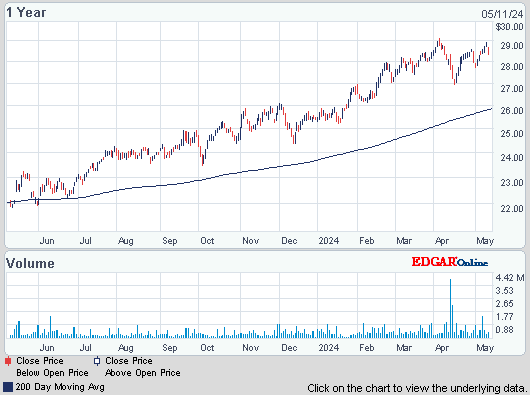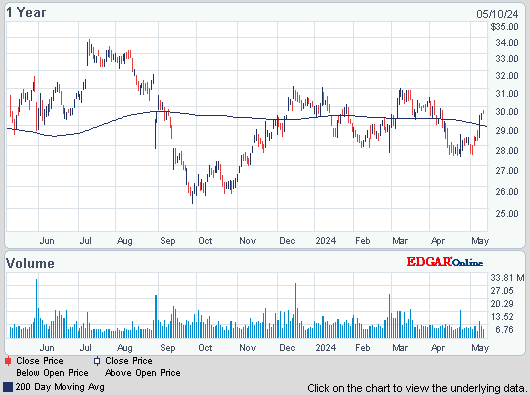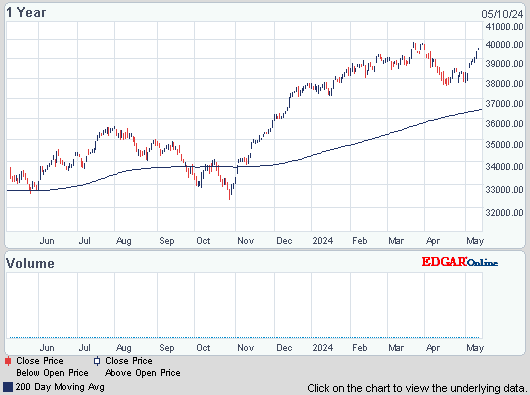Dow rose 24, advancers over decliners 3-2 & NAZ advanced 27. The MLP index was pennies lower into the 454s & the REIT index went up 2+ to the 267s. Junk bond funds rose while Treasuries pulled back a little. Oil fell
to the lowest level in almost 6 months as gov data
showed US crude stockpiles climbed for a 10th week. Gold declined for the 3rd
straight day after a report showed rising confidence among
American consumers, boosting speculation that the Federal
Reserve will scale back monetary stimulus.
AMJ (Alerian MLP Index tracking fund)

![Live 24 hours gold chart [Kitco Inc.]](http://www.kitco.com/images/live/gold.gif)


Photo: Bloomberg
Big Ben & colleagues are suffering thru their own form of cognitive dissonance: revealing new concerns about the economy’s long-term prospects even as they forecast faster growth in 2014. Worker productivity, a key component of an economy’s health, has risen at an annual clip of 1% during the last 4 years, as the US has struggled to recover from the worst recession in decades. That’s less than half the 2.2% average gain since 1983, according to the Labor Dept. “Slower growth in productivity might have become the norm,” the central bankers noted at their Oct meeting. That’s a switch from past comments by Bernanke that the deceleration probably was temporary & would end as the expansion continued. A combination of forces may be at work. Chastened by the deep economic slump, corp executives have reduced spending plans for factories, equipment, research & development. Startup businesses have been held back as would-be entrepreneurs find it harder to get financing from still-cautious lenders. And out-of-work Americans have seen their skills atrophy the longer they’re without jobs. A lasting decline in the growth of productivity, or nonfarm business output per employee hour, would be bad news for the economy. Its potential, the ability of the US to expand over an extended period without generating inflation, is determined by the sum of growth in the labor force & of productivity. A slowdown in the latter would limit how fast the US can develop in the future. That, in turn, would have far-reaching implications for policy makers, company execs, working Americans & investors. Fed officials would need to be more alert to inflation risks if growth picked up. Politicos would face even more difficulties reducing the budget deficit because tax receipts would be lower. Companies might have to settle for reduced revenue, employees for smaller paychecks & investors for diminished returns as a result of the slower expansion.
Fed Reveals New Concerns About Long-Term U.S. Slowdown

Photo: Bloomberg
Hewlett-Packard, a Dow stock, reported fiscal Q4 revenue & profit that topped estimates, boosted by corp demand for servers, PCs & networking equipment. The company said that revenue was $29.1B, exceeding the $27.8B estimate. EPS excluding some items was $1.01, compared with the $1 estimate. CEO Meg Whitman is cutting costs & amp; rebuilding relationships with customers & resellers to move past a period when the company churned thru 3 CEOs & lost share in many key markets. Business demand for PCs has helped offset a global slump, while Whitman renewed product development in areas including printers & computer servers. EPS was 73¢, compared with a $3.49 loss last year. Revenue in the same period a year earlier was $29.96B. Cash flow from operations increased 10%. A year ago, the company disclosed an investigation into accounting fraud at its Autonomy software unit, which it had bought for $10.3B & HPQ took an $8.8 writedown. EPS excluding some items will be 82-86¢ for the current period, compared with the 85¢ estimate. Whitman made her forecast even as the coming year has been a moving target. She had initially said revenue would rise in fiscal 2014 as PC sales stabilized, then scrapped that prediction in Aug amid a prolonged PC slump & weak demand for data-center equipment & services. At an Oct 9 meeting with analysts, she said the year-over-year sales decline would moderate after this year. On a conference call, Whitman said the company faces some challenges next year, citing “macroeconomic headwinds almost across the board” & aggressive pricing by the competition. The stock jumped 2.27

As American Airlines nears the end of 2 years in bankruptcy after winning approval to merge with US Airways, the equally arduous chore of creating the world’s biggest carrier is poised to begin. Led by US Airways CEO Doug Parker, the new American’s employees will act on plans crafted in the past 8 months, face structural tasks that include melding frequent-flier plans & deciding on a regional-jet fleet, as well as details such as picking an aircraft paint scheme. The closing of the $17.7B merger & AMR’s Chapter 11 exit will come Dec 9. Parker began pursuing American shortly after the bankruptcy filing 2 years ago. AMR agreed to the merger & the airlines worked toward a Sep closing until the Justice Dept filed an antitrust lawsuit to block the deal in Aug. A settlement in that case was reached 2 weeks ago & the.bankruptcy judge approved that accord today. The combined carrier will become American Airlines Group & the shares will be listed on NAZ with the ticker AAL. Equity in the merged airline will be distributed then, with 72% going to AMR creditors, including stakes totaling 23.6% for American employees & management, & at least 3.5% for existing AMR shareholders. Stockholders in US Airways will get the rest. Pay raises & other contract changes agreed to earlier for all employees will take effect that day as well. LCC rose 17¢.
AMR-US Airways Merger Checklist Spans Livery, Flier Plans

This was a sleepy day for the markets in very light trading. Even DC is not doing a lot when there is plenty of work to get done. Markets will close at 1PM on Fri, making for even lighter trading.
Dow Jones Industrials

AMJ (Alerian MLP Index tracking fund)
Treasury yields:
U.S. 3-month |
0.06% | |
U.S. 2-year |
0.28% | |
U.S. 10-year |
2.74% |
| CLF14.NYM | ....Crude Oil Jan 14 | ....92.21 | (1.6%) |
![Live 24 hours gold chart [Kitco Inc.]](http://www.kitco.com/images/live/gold.gif)


Photo: Bloomberg
Big Ben & colleagues are suffering thru their own form of cognitive dissonance: revealing new concerns about the economy’s long-term prospects even as they forecast faster growth in 2014. Worker productivity, a key component of an economy’s health, has risen at an annual clip of 1% during the last 4 years, as the US has struggled to recover from the worst recession in decades. That’s less than half the 2.2% average gain since 1983, according to the Labor Dept. “Slower growth in productivity might have become the norm,” the central bankers noted at their Oct meeting. That’s a switch from past comments by Bernanke that the deceleration probably was temporary & would end as the expansion continued. A combination of forces may be at work. Chastened by the deep economic slump, corp executives have reduced spending plans for factories, equipment, research & development. Startup businesses have been held back as would-be entrepreneurs find it harder to get financing from still-cautious lenders. And out-of-work Americans have seen their skills atrophy the longer they’re without jobs. A lasting decline in the growth of productivity, or nonfarm business output per employee hour, would be bad news for the economy. Its potential, the ability of the US to expand over an extended period without generating inflation, is determined by the sum of growth in the labor force & of productivity. A slowdown in the latter would limit how fast the US can develop in the future. That, in turn, would have far-reaching implications for policy makers, company execs, working Americans & investors. Fed officials would need to be more alert to inflation risks if growth picked up. Politicos would face even more difficulties reducing the budget deficit because tax receipts would be lower. Companies might have to settle for reduced revenue, employees for smaller paychecks & investors for diminished returns as a result of the slower expansion.
Fed Reveals New Concerns About Long-Term U.S. Slowdown

Photo: Bloomberg
Hewlett-Packard, a Dow stock, reported fiscal Q4 revenue & profit that topped estimates, boosted by corp demand for servers, PCs & networking equipment. The company said that revenue was $29.1B, exceeding the $27.8B estimate. EPS excluding some items was $1.01, compared with the $1 estimate. CEO Meg Whitman is cutting costs & amp; rebuilding relationships with customers & resellers to move past a period when the company churned thru 3 CEOs & lost share in many key markets. Business demand for PCs has helped offset a global slump, while Whitman renewed product development in areas including printers & computer servers. EPS was 73¢, compared with a $3.49 loss last year. Revenue in the same period a year earlier was $29.96B. Cash flow from operations increased 10%. A year ago, the company disclosed an investigation into accounting fraud at its Autonomy software unit, which it had bought for $10.3B & HPQ took an $8.8 writedown. EPS excluding some items will be 82-86¢ for the current period, compared with the 85¢ estimate. Whitman made her forecast even as the coming year has been a moving target. She had initially said revenue would rise in fiscal 2014 as PC sales stabilized, then scrapped that prediction in Aug amid a prolonged PC slump & weak demand for data-center equipment & services. At an Oct 9 meeting with analysts, she said the year-over-year sales decline would moderate after this year. On a conference call, Whitman said the company faces some challenges next year, citing “macroeconomic headwinds almost across the board” & aggressive pricing by the competition. The stock jumped 2.27
Hewlett-Packard (HPQ)
As American Airlines nears the end of 2 years in bankruptcy after winning approval to merge with US Airways, the equally arduous chore of creating the world’s biggest carrier is poised to begin. Led by US Airways CEO Doug Parker, the new American’s employees will act on plans crafted in the past 8 months, face structural tasks that include melding frequent-flier plans & deciding on a regional-jet fleet, as well as details such as picking an aircraft paint scheme. The closing of the $17.7B merger & AMR’s Chapter 11 exit will come Dec 9. Parker began pursuing American shortly after the bankruptcy filing 2 years ago. AMR agreed to the merger & the airlines worked toward a Sep closing until the Justice Dept filed an antitrust lawsuit to block the deal in Aug. A settlement in that case was reached 2 weeks ago & the.bankruptcy judge approved that accord today. The combined carrier will become American Airlines Group & the shares will be listed on NAZ with the ticker AAL. Equity in the merged airline will be distributed then, with 72% going to AMR creditors, including stakes totaling 23.6% for American employees & management, & at least 3.5% for existing AMR shareholders. Stockholders in US Airways will get the rest. Pay raises & other contract changes agreed to earlier for all employees will take effect that day as well. LCC rose 17¢.
AMR-US Airways Merger Checklist Spans Livery, Flier Plans
US Airways (LCC)
This was a sleepy day for the markets in very light trading. Even DC is not doing a lot when there is plenty of work to get done. Markets will close at 1PM on Fri, making for even lighter trading.
Dow Jones Industrials
I’m a huge fan of INO, & from what I have seen so far, their service Marketclub! This isn’t a stripped down version, everything in MarketClub is available to you. I don’t want to give everything away, but you’ll have unlimited access to my favorite three tools: Trade Triangles, Smart Scan & Alerts! The best part is that the MarketClub customer support team will be providing UNLIMITED support! You can call or email for an instant response to any question, comment or concern.
Here’s that link:
https://club.ino.com/join/specialtrial/index_free.html?a_aid=CD3289&a_bid=359ef9a3
I’d recommend you jump on this now.







No comments:
Post a Comment